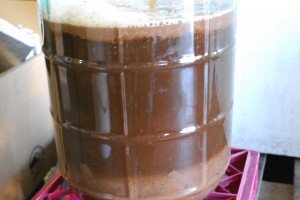October 23, 2018
Jan Roten & Roten Jan Flemish Red Recipe
Hey hey, my my. The wine is gone, but not forgotten - this is the story of Jan Roten (and Roten Jan). I have put a lot of miles on this medium-toast French; it was the first barrel I ever bought and has oaked a number of wine kits. Barrel-fermented a Chardonnay to break it in, and since then it's held many reds, including a very good Pinot Noir and, most recently, a Barbera that was bottled just around the time the snow started to disappear. It's allowed a lot of gentle, slow oxygen uptake over the years and it's given a lot of tannin. Given pretty much all it can, in fact.
Now it's time to cram its stripped, grape-stained pores so full of Brettanomyces that it can never be truly clean again. Yay!
In a decision owing no small part to figuring out what to do with a, this pack of Wyeast Roeselare just sitting around, and b, this 5 year-old Dawson's Kriek kit I keep putting off bottling, it was determined that mon Cask Ancienne should enjoy an active retirement playing host to sour ales ... because it's better to burn out than to fade away.
That can only mean one thing: a fridge-, freezer-, grain bin-, and carboy-clearing Flemish red type of deal:
Jan Roten/Roten Jan
10 gallons, all-grain.
Target OG: 1.051
Grist:
- 8 lbs Franco-Belges pils
- 8 lbs Munich 20 EBC
- 1 lb English medium crystal
- 4 oz Carafa II
Mash: An old-school regimen from Wild Brews, with a high-temp dextrin rest (162 F) to give the Brett in the Roeselare blend plenty to nosh on:
- 122 F for 20 min
- 145 F for 40 min
- 162 F for 30 min
- 168 F for 5 min
Boil:
- 2 oz Palisade @ 60"
Fermentation: Yeast never sleeps. Primary fermentation was conducted with:
- Wyeast 1056 American Ale
... for a nice, neutral base beer to then sour. After 25 days in the conical, it came out with a rich golden-red color and a hefty, husky malt profile like an overstated Maerzen or an underfed bock. I experienced a momentary twinge of regret as I imagined subjecting this young, bright ale to the depredations of time, bugs, acid and wood.
But only momentary.
Splitting, souring, blending, and stuff:
Or, out of the brew, into the cask.
Half of the 10 gallon batch went into the oak barrel to party with a pack of Wyeast 3763 Roeselare and whatever flavors the ghosts of wines past can offer - this is Jan Roten. He'll stay put for 12-18 months or so, but evaluation of periodic barrel samples and the whims of the 3763 will trump any timeline I impose at this point. No carts before horses; we shall see what we shall see.
The other half - Roten Jan - was blended with a well-aged, intensely sour, funky-cherry-pie-tasting kriek (brewed in April 2006); the fresh beer will temper the acidity (initially) and provide some fresh yeast to generate carbonation.
 |
 |
Never being one to pass up an opportunity to use a graduated cylinder (cheers, Mr. Langhus's 3rd period Chem), and not wishing to just randomly dump and stir a 5 1/2-year old beer, a bench trial the day before blending/bottling day told me what I needed to know: 2 parts young beer to 1 part old beer gave the most pleasing balance of clean malt sweetness, fruit-and-Brett cherry notes, and sour esophagus-scraping acid. Sugar-primed and handsomely packaged, can't wait to start drinking this one when the bottles carbonate (look for tasting notes in an upcoming episode of Brewing TV).
... and finally:
Because I believe in using all parts of the buffalo, I did not dump out the cherry solid- and lambic bacteria-ridden slurry left after racking and blending the kriek.

No, friends, what I did instead was incorporate it in succession into two different 5-gallon batches of Caribou Slobber brown ale - punched up with Brettanomyces and amplified with souring bacteria, clearly what we have now is an Amero-Belgian table-strength Flemish sour brown - an Oud Caribruin, if you will.
Oud Caribruin #1 got two weeks in heaven with what I affectionately labeled "kriek guts" and the impact of that big bacterial bolus was felt fast. After a mere 14 days it was nicely funky and leathery with strong raisin and baking chocolate notes still remaining from the base beer ... and so it was kegged and carbed. Clink em and drink em, as they almost certainly do not say in Oudenaarde.
Oud Caribruin #2 recycled the same kriek guts with the addition of plum puree ... and there it sits. See you in 2016, baby.
